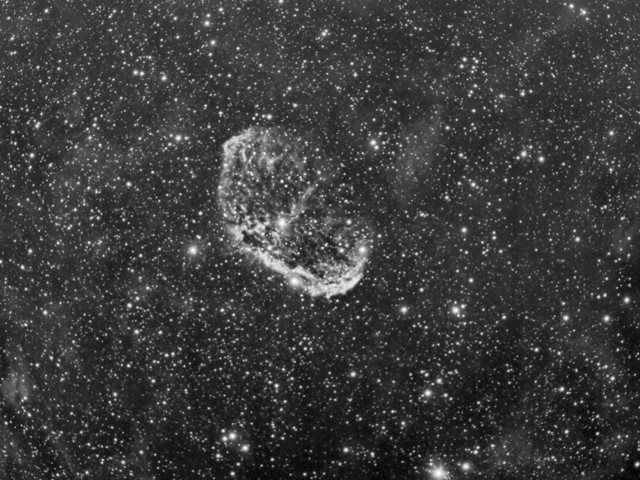The Crescent Nebula (NGC 6888), also called the Crescent Nebula or Caldwell 27, is an emission nebula in the constellation Cygnus, located 6° southwest of Sadr (γ Cygni). It is located about 4700 light-years away from Earth.
Formed by the strong stellar wind originated by the Wolf-Rayet star HD 192163 (WR 136) that collides and dynamizes the slower wind that ejected the star when it became a red giant about 400,000 years ago.
Because of this collision, an envelope and two shock waves have formed, one moving outward and one moving inward. The shock wave moving inland heats the stellar wind to temperatures where X-rays are emitted.

Technical data:
Telescope: SkyWatcher ED80
CCD:Atik314L+
Focal Length Reducer: SW 0.8x
Filters: Ha 12nm
Telescope Guide: S/C 8″
Mount: LX200 GPSR Guide CCD: QHY5
CCD Temp:-3º
Ambient Temp:21º/19º
Location: Anunaki Observatory / Rivas Vaciamadrid (Madrid)
WR 136 is a Wolf-Rayet star of spectral type WN6 with a luminosity 500,000 times that of the Sun. It has a surface temperature of 73,000º K (72,700º C). Its age is estimated at only 4.5 million years, one-thousandth of the age of the Sun, but it is already in the final phases of its stellar evolution. It was previously a red supergiant with a mass 30 times that of the Sun and about 250,000 years ago it ejected its outer layers. Now, in its phase as a Wolf-Rayet star, the material that was expelled is hit by the strong stellar wind that arises from the star and heated, so it glows again, forming the emission nebula.
The star loses mass very quickly, the equivalent of solar mass every 10,000 years. It is estimated that in about 100,000 years — if it is still massive enough — it will explode as a supernova.

Technical data:
Telescope: SkyWatcher ED80
CCD:Atik314L+
Focal Length Reducer: SW 0.8x
Filters: Ha 12nm/O[III]12nm/S[II]12nm
Telescope Guide: S/C 8″
Mount: LX200 GPSR Guide CCD: QHY5
CCD Temp:-3º
Ambient Temp:21º/19º
Location: Anunaki Observatory / Rivas Vaciamadrid (Madrid)
It has recently been proposed that WR 136 may be a binary star. Its companion, of spectral type K or M, would take just over 5 days to complete an orbit around the main star, being in such a case the system a possible precursor of a binary of low-mass X-rays.
